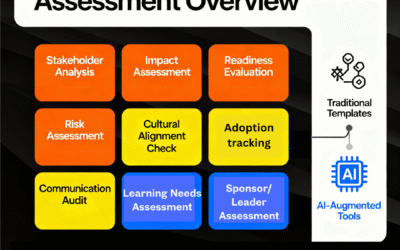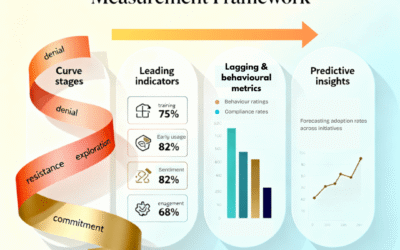Data Foundations and the Limits of Traditional Reporting
Change and transformation leaders are increasingly tasked with supporting decision making through robust, actionable reporting. Despite the rise of specialist tools, teams still lean heavily on Excel and Power BI because of their familiarity, ease and widespread adoption. However, as the pace and scale of organisational change accelerate, these choices reveal critical limitations, especially in supporting nuanced organisational insights.
Why High, Medium, Low Reporting Falls Short
Many change teams default to tracking change impact and volume using simple “high, medium, low” traffic light metrics. While this method offers speed and clarity for basic reporting, it fails to capture context, regional nuance, or the real intensity of change across diverse teams. This coarse approach risks obscuring important details, leaving senior leaders without the depth needed to target interventions or accurately forecast operational risks.
Change practitioners are often short on time and choosing whatever is easier and faster often becomes the default choice, i.e. Excel. This short-sighted approach focuses on quickly generating an output to try and meeting stakeholder needs without thinking strategically what makes sense at an organisational level, and the value of change data to drive strategy and manage implementation risks.
Data Capture: Getting the Inputs Right
Excel’s flexibility lets teams start capturing change data quickly, but often at the expense of structure. When fields and templates vary, information can’t be standardized or consistently compared. Manual entry introduces duplication, missing values, and divergent interpretations of change categories. Power BI requires disciplined and structured underlying data to function well; without careful source management, output dashboards reflect input chaos rather than clarity. Therefore, when pairing Excel with Power BI chart generation, often a BI (business intelligence) specialist is required to help configure and structure the chart outputs in Power BI.
Tips for effective data capture:
- Establish clear data templates and definitions before rolling out change tracking.
- Centralize where possible to avoid data silos and redundant records.
- Assign responsibilities for maintaining quality and completeness at the point of entry.
Data Cleansing and Auditing: Maintaining Integrity
Excel and Power BI users are frequently responsible for manual data validation. The process is time-consuming, highly error-prone, and often fails to catch hidden inconsistencies, especially as data volumes grow. Excel’s lack of built-in auditing makes it tough to track changes or attribute ownership, increasing risks for compliance and reliability.
Best practices for cleansing and auditing:
- Automate as much validation as possible, using scripts or built-in platform features.
- Use a single master source rather than local versions to simplify updates.
- Develop version control and change logs to support traceability and confidence in reporting.
Visualization, Dashboarding, and Interpretation Challenges in Change Reporting
After establishing robust data foundations, the next hurdle for senior change practitioners is translating raw information into clear, actionable insights. While Excel and Power BI each provide capabilities for visualizing change data, both bring unique challenges that can limit their effectiveness in supporting strategic decision making.
Visualization and Dashboard Design
Excel’s charting options are familiar and flexible for simple visualizations, but quickly become unwieldy as complexity grows. Static pivot charts and tables, combined with manual refreshing, reduce the potential for interactive analysis. Power BI offers more engaging, dynamic visuals and interactive dashboards, yet users frequently run into formatting frustrations, such as limited customization, bulky interfaces, and difficulties aligning visuals to precise narrative goals.
Some specific visualization and dashboard challenges include:
- Difficulty representing complex, multidimensional change metrics within simplistic dashboards, e.g. impact by stakeholder by location by business unit by type of change.
- Limited ability in both tools to customize visual details such as consistent colour themes or layered insights without significant effort.
- Dashboard performance degradation with very large or complex datasets, reducing responsiveness and usability.
Interpreting Data and Supporting Decision Making
Effective dashboards must not only display data properly but also guide users toward meaningful interpretation. Both Excel and Power BI outputs can suffer when change teams focus too heavily on volume metrics or simple aggregated scores (like high/medium/low, or counting activities such as communication sent) without contextualizing underlying drivers. This can mislead executives into overgeneralized conclusions or missed risks.
Challenges include:
- Dashboards overwhelmed by numbers without narrative or highlight indicators.
- Difficulty embedding qualitative insights alongside quantitative data in either tool.
- Sparse real-time feedback loops; often snapshots lag behind ongoing operational realities.
Tips and Tricks for Effective Visualization and Insights
- Limit dashboard visuals to key metrics that align tightly with decision priorities; avoid clutter.
- Use conditional formatting or custom visuals (in Power BI) to draw attention to anomalies or trends.
- Build interactive filters and drill-downs to enable users to explore data layers progressively.
- Combine quantitative data with qualitative notes or commentary fields to bring context to numbers.
- Schedule regular dashboard updates and ensure data pipelines feed timely, validated information.
Once the foundation of reliable data capture and cleansing is set, the next major hurdle for senior change practitioners is transforming raw change data into clear, actionable insights. Excel and Power BI both offer visualization and dashboarding capabilities, yet each presents challenges that can limit their effectiveness in supporting strategic decision-making.
Visualization and dashboard design challenges
Excel’s charting features are familiar and flexible for simple visuals but quickly become cumbersome as complexity grows. Its static pivot charts and manual refresh cycles limit interactive exploration. Power BI adds interactive and dynamic visualizations but users often encounter limitations such as restricted formatting options, bulky interfaces, and considerable effort required to tailor visuals to convey precise change narratives.
Specific challenges include:
- Struggling to represent complex, multi-dimensional change metrics adequately within simplistic dashboards.
- Limited ability to apply consistent colour schemes or layered insights without advanced customization.
- Performance degradation in dashboards when datasets become large or complex, impacting responsiveness and user experience.
Data interpretation and decision-making support
A dashboard’s true value comes from guiding users towards meaningful interpretation rather than just presentation of numbers. Both Excel and Power BI outputs may fall short if change teams rely excessively on aggregated volume metrics or high/medium/low scales without embedding context or deeper qualitative insight. This risks executives making generalized conclusions or overlooking subtle risks.
Key challenges include:
- Dashboards overrun with numbers lacking narrative or prioritized highlights.
- Difficulty integrating qualitative insights alongside quantitative data within either platform.
- Reporting often static or delayed, providing snapshots that lag behind real-time operational realities.
Tips and tricks for more effective visualization and insight generation
- Restrict dashboards to key metrics closely aligned with leadership priorities to avoid clutter.
- Leverage conditional formatting or Power BI’s custom visuals to highlight trends, outliers or emerging risks.
- Incorporate interactive filters and drill-downs allowing users to progressively explore data layers themselves.
- Pair quantitative dashboards with qualitative commentary fields or summary narratives to provide context.
- Implement disciplined refresh schedules ensuring data pipelines are timely and validated for ongoing accuracy.
Practical advice for change teams and when to consider dedicated change management tools
Change teams vary widely in size, maturity, and complexity of their reporting needs. For less mature or smaller teams just starting out, Excel often remains the most accessible and cost-effective platform for capturing and communicating change-related data. However, as organisational demands grow in complexity and leadership expects richer insights to support timely decisions, purpose-built change management tools become increasingly valuable.
Excel as a starting point
For teams in the early stages of developing change reporting capabilities, Excel offers several advantages:
- Familiar user interface widely known across organisations.
- Low entry cost with flexible options for data input, simple visualizations, and ad hoc analysis.
- Easy to distribute offline or via basic file-sharing when centralised platforms are unavailable.
However, small teams should be mindful of Excel’s limitations and implement these best practices:
- Design standardised templates with clear field definitions to improve consistency.
- Concentrate on key metrics and avoid overly complex sheets to reduce error risk.
- Apply version control discipline and regular data audits to maintain data accuracy.
- Plan for future scalability by documenting data sources and formulas for easier migration.
Progressing to Power BI and beyond
As reporting needs mature, teams can leverage Power BI to create more dynamic, interactive dashboards for leadership. The platform offers:
- Integration with multiple data sources, enabling holistic organisational views.
- Rich visualizations and real-time data refresh capabilities.
- Role-based access control improving collaboration and data governance.
Yet Power BI demands some specialist skills and governance protocols:
- Teams should invest in upskilling or partnering internally to build and maintain reports.
- Establish rigorous data governance to avoid “data swamp” issues.
- Define clear escalation paths for dashboard issues to maintain reliability and trust.
When to adopt purpose-built change management platforms
For organisations undergoing complex change or those needing to embed change reporting deeply in strategic decision making, specialist tools like The Change Compass provide clear advantages:
- Tailored data models specific to change management, capturing impact, readiness, resistance, and other essential dimensions.
- Automated data capture integrations from multiple enterprise systems reducing manual effort and errors.
- Advanced analytics and visualizations designed to support executive decision making with predictive insights and scenario planning, leveraging AI capabilities.
- Ease of creating/editing chart and dashboards to match stakeholder needs, e.g. The Change Compass has 50+ visuals to cater for the most discerning stakeholder
- Collaboration features aligned to change team workflows.
- Built-in auditing, compliance, and performance monitoring focused on change initiatives.
Purpose-built platforms significantly reduce the effort required to turn change data into trusted, actionable insights, freeing change leaders to focus on driving transformation rather than managing reporting challenges.
Summary advice for change teams
| Stage | Recommended tools | Focus areas |
| Starting out | Excel | Standardise templates, focus on core metrics, enforce data discipline |
| Developing maturity | Power BI | Build dynamic dashboards, establish governance, develop reporting skills |
| Complex change environments | Purpose-built enterprise platforms (e.g. The Change Compass) | Integrate systems, leverage tailored analytics, support operations and executive decisions |
Selecting the right reporting approach depends on organisational scale, available skills, and leadership needs. Recognising when traditional tools have reached their limits and investing in specialist change management platforms ensures reporting evolves as a strategic asset rather than a bottleneck.
This staged approach supports both incremental improvements and long-term transformation in how change teams provide decision support through high-quality, actionable reporting.
Practical advice for change teams and when to consider dedicated change management tools
Change teams vary widely in size, maturity, and complexity of their reporting needs. For less mature or smaller teams just starting out, Excel often remains the most accessible and cost-effective platform for capturing and communicating change-related data. However, as organisational demands grow in complexity and leadership expects richer insights to support timely decisions, purpose-built change management tools become increasingly valuable.
Excel as a starting point
For teams in the early stages of developing change reporting capabilities, Excel offers several advantages:
- Familiar user interface widely known across organisations.
- Low entry cost with flexible options for data input, simple visualizations, and ad hoc analysis.
- Easy to distribute offline or via basic file-sharing when centralised platforms are unavailable.
However, small teams should be mindful of Excel’s limitations and implement these best practices:
- Design standardised templates with clear field definitions to improve consistency.
- Concentrate on key metrics and avoid overly complex sheets to reduce error risk.
- Apply version control discipline and regular data audits to maintain data accuracy.
- Plan for future scalability by documenting data sources and formulas for easier migration.
Progressing to Power BI and beyond
As reporting needs mature, teams can leverage Power BI to create more dynamic, interactive dashboards for leadership. The platform offers:
- Integration with multiple data sources, enabling holistic organisational views.
- Rich visualizations and real-time data refresh capabilities.
- Role-based access control improving collaboration and data governance.
Yet Power BI demands some specialist skills and governance protocols:
- Teams should invest in upskilling or partnering internally to build and maintain reports.
- Establish rigorous data governance to avoid “data swamp” issues.
- Define clear escalation paths for dashboard issues to maintain reliability and trust.
When to adopt purpose-built change management platforms
For organisations with complex change environments or those needing to embed change reporting deeply in strategic decision making, specialist tools like The Change Compass provide clear advantages:
- Tailored data models specific to change management, capturing impact, readiness, resistance, and other essential dimensions.
- Automated data capture integrations from multiple enterprise systems reducing manual effort and errors.
- Advanced analytics and visualizations designed to support executive decision making with predictive insights.
- Collaboration features aligned to change team workflows.
- Built-in auditing, compliance, and performance monitoring focused on change initiatives.
Purpose-built platforms significantly reduce the effort required to turn change data into trusted, actionable insights, freeing change leaders to focus on driving transformation rather than managing reporting challenges.
Selecting the right reporting approach depends on organisational scale, available skills, and leadership needs. Recognising when traditional tools have reached their limits and investing in specialist change management platforms ensures reporting evolves as a strategic asset rather than a bottleneck.
This staged approach supports both incremental improvements and long-term transformation in how change teams provide decision support through high-quality, actionable reporting. With greater maturity, change teams also start to invest in various facets of data management, from data governance, data cleansing and data insights to provide a significant lift in perceived value by senior business stakeholders.





